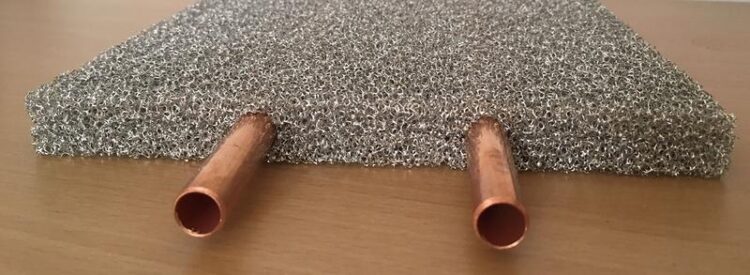New approach to increasing range and comfort in fuel cell-powered rail transport

Zellulare Struktur mit integriertem Wärmeträgerrohr als Grundlage für die Optimierung der Oberflächentemperaturverteilung.
TU Dresden
Hydrogen technology will also be used on rails in the future. In the future, regional trains will be equipped with fuel cells that convert oxygen and hydrogen into electrical energy. In its “Heat2Comfort” project, funded by the BMWI, the Fraunhofer Institute for Manufacturing Technology and Advanced Materials IFAM in Dresden is contrib-uting to this type of emission-free and low-noise mode of transport.
Together with its partners, the Hörmann Vehicle Engineering GmbH, the Wärme-tauscher Sachsen GmbH as well as the Institute of Air Handling and Refrigeration Ge-meinnützige Gesellschaft mbH, the institute is working on a new approach to waste heat utilization for vehicle air conditioning. In addition, the partners are supported by DB Systemtechnik GmbH, DB RegioNetz Verkehrs GmbH and the Energieanlagenbau GmbH Westenfeld.
The central idea of the approach is to effectively utilize the waste heat from the fuel cell for temperature control of the vehicle interior. The goal is to increase the mini-mum range of fuel cell trainsets by 20 %. At the same time, passenger comfort is to be increased both thermally and acoustically.
The aim is to cover both heating and air-conditioning requirements with the waste heat from the fuel cell. This means that the waste heat can even be used for indoor air conditioning in summer operation by supplying an absorption heat pump with the waste heat from the fuel cell to generate the air-conditioning.
As a result, the electricity from the fuel cell can be used in concentrated form for pro-pulsion and does not have to be used for air conditioning. In contrast, today’s vehicles require up to 25 % of the total energy demand for air conditioning in the passenger compartment and driver’s cab. Efficient use of the available fuel cell waste heat is a major factor influencing the increase in range.
In addition to its expertise in materials science, the business unit Energy and Thermal Management at Fraunhofer IFAM Dresden is contributing its know-how in the thermal and fluidic development of components to the “Heat2Comfort” project. This is com-plemented by extensive experience in mathematical modeling and experimental valida-tion of flow, heat and mass transfer processes.
Specifically, the researchers within the project are concerned with coupling the heat source, i.e. the fuel cell, with the various heat uses in the form of absorption cooling and room heating. This is done via PCM storage units in which fiber structures are used to adapt the storage capacity.
Additionally, the thermal activation of interior surfaces and other fittings such as table and seat structures is considered.
The many years of expertise at Fraunhofer IFAM Dresden in the field of cellular metallic materials also benefits the optimization of the temperature distribution on the surfac-es. For example, findings from the recently completed project “Hybrid-FHKL” are be-ing utilized. Here, hybrid heating and cooling surfaces with room air conditioning for building services were developed and investigated. The use of cellular metals to gener-ate uniform surface temperatures is a central question that is also relevant in “Heat2Comfort”.
Fraunhofer IFAM Dresden also carries out simulations of energy flows, storage behav-ior, and the design of cellular metallic materials for thermal component activation.
Wissenschaftliche Ansprechpartner:
Dr.-Ing. André Schlott
Weitere Informationen:
https://www.ifam.fraunhofer.de/en/Profile/Locations/Dresden/Energy_and_thermal_m…
Media Contact
All latest news from the category: Power and Electrical Engineering
This topic covers issues related to energy generation, conversion, transportation and consumption and how the industry is addressing the challenge of energy efficiency in general.
innovations-report provides in-depth and informative reports and articles on subjects ranging from wind energy, fuel cell technology, solar energy, geothermal energy, petroleum, gas, nuclear engineering, alternative energy and energy efficiency to fusion, hydrogen and superconductor technologies.
Newest articles

Innovative 3D printed scaffolds offer new hope for bone healing
Researchers at the Institute for Bioengineering of Catalonia have developed novel 3D printed PLA-CaP scaffolds that promote blood vessel formation, ensuring better healing and regeneration of bone tissue. Bone is…

The surprising role of gut infection in Alzheimer’s disease
ASU- and Banner Alzheimer’s Institute-led study implicates link between a common virus and the disease, which travels from the gut to the brain and may be a target for antiviral…

Molecular gardening: New enzymes discovered for protein modification pruning
How deubiquitinases USP53 and USP54 cleave long polyubiquitin chains and how the former is linked to liver disease in children. Deubiquitinases (DUBs) are enzymes used by cells to trim protein…



